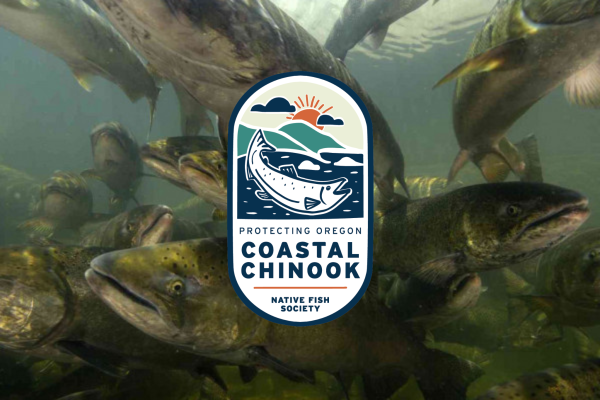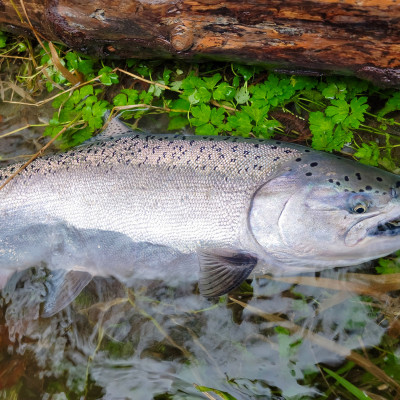Spring Chinook Salmon (also referred to as springers) are an essential species to the rivers of the Oregon Coast. Not only are they a keystone species in the ecosystem, playing a vital role in maintaining the health of the river and its food web, but the spring Chinook Salmon run has cultural and spiritual significance for local tribes and communities, who have relied on the fish for sustenance for thousands of years. Preserving and protecting the spring Chinook Salmon and their habitats is essential for the long-term health and sustainability of the rivers of the Oregon Coast and the communities that depend on them.
The Threat:
Spring Chinook Salmon along the Oregon coastal face significant adverse challenges that are threatening their populations. One of the primary threats is the destruction of cold water habitat high in coastal watersheds that springers use to wait out the long hot summers before spawning in the early fall. Dams are also a major threat to spring Chinook, with Winchester and Soda Springs dams challenging the relatively healthy population of springers in the North Umpqua River. Dams that create a barrier to upstream migration increase the likelihood that spring Chinook spawn with fall Chinook lower in the watershed, creating hybrid offspring. These hybrid offspring have an intermediate run time, resulting in fish that are coming into rivers when temperatures are highest, in turn resulting in high pre-spawn mortality.
Climate change, hatchery introgression, and ocean harvest in mixed-stock fisheries are also contributing factors that are putting spring Chinook Salmon at risk.
New research into the genetic origins of spring Chinook run timing suggests that if their populations are extirpated (meaning they are locally extinct even if they still exist in other watersheds), co-occurring fall Chinook cannot reestablish spring Chinook populations. Instead, once lost, the unique spring Chinook Salmon life history is unlikely to re-evolve within any kind of human timeframe.
To protect and revive this valuable fish, it is important to recognize them as a threatened or endangered species under the federal Endangered Species Act. An ESA designation will lead to the conservation of critical habitat and full volitional fish passage to support healthy populations of wild spring Chinook Salmon.
Our key areas of focus for Spring Chinook on the Oregon Coast are Habitat and Hydropower. Learn more about the science behind the 5 H’s and their importance to the revival of wild abundance here.
Our Goals:
Native Fish Society's goal is to prevent the extinction of Spring Chinook in the Umpqua and Siletz watersheds and to restore functionally extinct populations back to historic abundance. We want to acknowledge Spring Chinook as a critical life history variant that is necessary for the long-term survival of the entire Oregon and North California Coastal Chinook evolutionarily significant units (ESUs), and are therefore in need of federal protections under the Endangered Species Act. Additionally, our goal is to end augmentation hatchery efforts on streams where they endanger the continued existence of wild populations.
How is NFS working to achieve our goal?
We are working on reformations to ensure that harvest and hatchery management of Spring Chinook salmon throughout Oregon coastal rivers does not exceed the biological limits for the population.
Successes & Accomplishments to Date:
Native Fish Society submitted a new petition to the National Marine Fisheries Service (NMFS) on August 3, 2022 calling to list Oregon Coast and Southern Oregon/North California Coastal Chinook ESUs as threatened or endangered under the Endangered Species Act
This petition went into 90-day review on August 30, 2022 and this initial review resulted in NMFS giving it a "positive" finding, meaning it will be further considered. A 60-day comment period began on January 11, 2023 that allows agencies to submit additional data to NMFS. Following this comment period, NMFS will have 12 months to make their final decision on the petition.
Spring 2022: No retention of Spring Chinook allowed in the North Umpqua Fishery
Fall 2021: ODFW Commission directed their department to evaluate adaptive management changes to the Coastal Multi-Species Management Plan for South Umpqua Spring Chinook.
Fall 2021: NOAA declines to list Spring Chinook separately from Fall Chinook for the Oregon Coast and Southern Oregon /Northern California populations.
Notice of Intent to sue filed March 31, 2021, in an effort to push NOAA Fisheries to issue a final finding determination on the listing.
NOAA issued a positive finding on our petition to consider listing Oregon Coast Spring Chinook; the agency initiated a formal consideration process.
Spring Chinook recreational fishery was canceled on the lower Umpqua River to protect fish returning to the South Umpqua in part by efforts made through Action Alerts and attending commission meetings.
The Board of Forestry incorporated spring Chinook into the potentially listed species for coverage in the Western Oregon HCP
CDFW Commissioners vote to list Klamath-Trinity ChS as CESA threatened an Eel StS
How Can You Help?
Get involved!
You can help make a difference in protecting the incredible and essential Spring Chinook fish by volunteering, making a donation, or spreading the word about the importance of reviving these vital native fish. Send us a message if you have any questions, or would like to be notified of any upcoming volunteer opportunities and/or Action Alerts for the protection and revival of Spring Chinook on the Oregon Coast.



